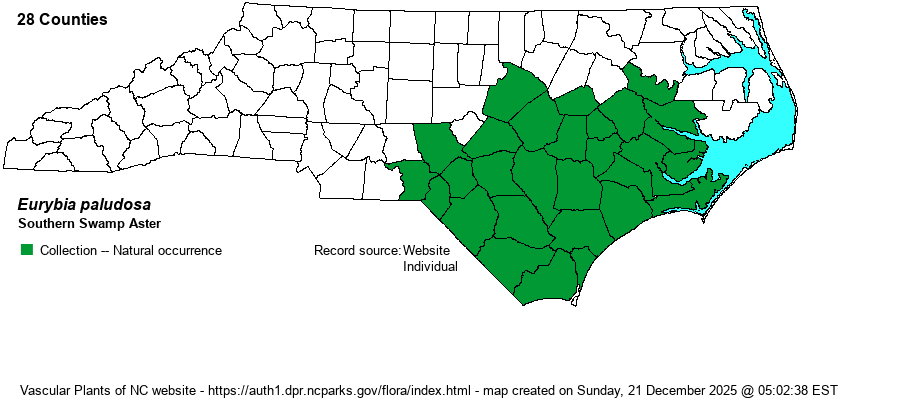| Author | (Aiton) Nesom | |
| Distribution | Coastal Plain and Sandhills, but absent in the northern and northeastern regions. Records from the NC Mountains need careful check vs. E. avita and E. hemispherica but clearly cannot be E. paludosa based on its moist pineland habitats and Coastal Plain range.
Coastal Plain, NC to northeastern FL.
| |
| Abundance | Fairly common to common in the Sandhills and southern Coastal Plain, less numerous into the central Coastal Plain. Single, elongate, sterile leaves may be numerous in the vicinity of flowering plants; they probably represent immature individuals. | |
| Habitat | Wet to permanently moist pine savannas and flatwoods, blackwater streamheads and ecotones, pitcher-plant seeps. This is a characteristic aster of pine-dominated wetlands. | |
| Phenology | Flowering and fruiting late July-October. | |
| Identification | The genus Eurybia has been split from Aster (now Symphyotrichum). Variation among species of each genus requires several steps in a key to split members of the two genera apart (see genus key in Weakley 2018).
This is a slender plant up to 2.5 feet tall, with slender leaves, showy blue-lavender rays and bright yellow disks. Basal and lower stem leaves are very long-stalked, grass-like, up to 8 inches long but at most 2/5-inch wide. Stem leaves progressively become smaller, short-stalked or stalkless. This is a very handsome plant in bloom! E. hemispherica is very similar (and was formerly included within this species) but is an upland plant, recorded in the mountains, but its inflorescence is somewhat of a raceme -- flowers more along the stem axis, as opposed to a rather flat-topped flower cluster in E. paludosa. | |
| Taxonomic Comments | Formerly treated as Aster paludosus.
| |
| Other Common Name(s) | Savannah Grass-leaved Aster, Grass-leaved Aster. This species has often not had a well-used common name, but many websites now hone in on Southern Swamp Aster, for better or worse. | |
| State Rank | S4 [S4S5] | |
| Global Rank | [G5] | |
| State Status | | |
| US Status | | |
| USACE-agcp | FACW link |
| USACE-emp | FACW link |

